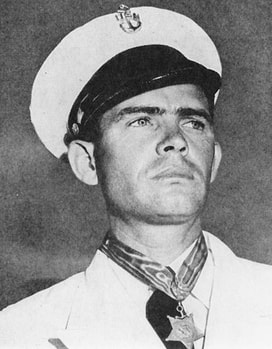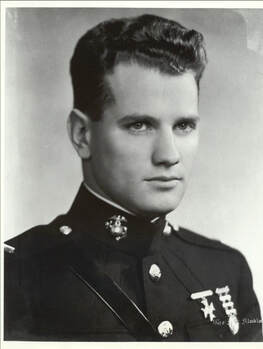Eighty-two years ago, on December 7, 1941, the Japanese Empire launched a surprise attack on the U.S. base at Pearl Harbor that was intended to knock the United States out of a war in the Pacific. Instead, it raised the anger and heroic, fighting spirit of the American people and caused our entry into World War II. Countless acts of heroism and sacrifice occurred on that day, and sixteen men were awarded the medal of honor. Some people are surprised to know that the attack went far beyond the borders of Pearl Harbor, and that the casualties stretched beyond Navy personnel.
The first target of the striking Japanese bomber and fighter planes was the Marine Corps Air Station at Ewa, on Oahu’s northern shore. Although the runway was not bombed and remained serviceable, all forty-eight aircraft based there were destroyed
 Chief Aviation Ordnanceman John William Finn with his Medal of Honor (Photo: Naval History & Heritage Command)
Chief Aviation Ordnanceman John William Finn with his Medal of Honor (Photo: Naval History & Heritage Command)The Naval Air Station at Kaneohe Bay, on Oahu’s eastern side was hit next. Chief Aviation Ordnanceman John William Finn was in charge of a 20-man unit whose main job was to maintain the weapons on PBY Catalina flying boats stationed there. On the morning of the 7th, he was at home when he heard gunfire and a neighbor started banging on his door to tell him he was needed at his squadron. He drove the mile to the airfield and found most of the Catalinas already burning. He joined his men, who were firing back at the Japanese flyers, either by climbing into the burning Catalina’s to use their guns, or by taking the guns off and putting them on other mounts. Finn pulled a .50 caliber M2 Browning machine gun from the unit’s painter, placed it on a mount, and opened fire. Although he suffered a total of 21 wounds, including a bullet through his foot and another one through his shoulder, he continued firing for two hours. When Finn died in 2010 at the age of 100, he was the last surviving Medal of Honor recipient from the Battle of Pearl Harbor. He remains the only aviation ordnanceman to ever receive the decoration.
Most people know that the greatest loss of life during the attack at Pear Harbor happened on the USS Arizona. Of the 2,341 service members that died on Dec. 7, 1941, almost half, a total of 1,177, died on that one ship. The high mortality rate was due to the detonation of the forward magazines when a bomb hit them, killing more than two-thirds of her crew. The crew of the USS Arizona included 38 sets of brothers, including three sets of three brothers. Of those 79 people, 63 died as a result of the attack. Of the ship’s 82 Marines, only 3 officers and 12 enlisted men survived.
Real Admiral Isaac Campbell Kidd, the commander of Battleship Division One, which included the USS Pennsylvania, Arizona and Nevada, rushed to the Arizona, the flagship for the division, as soon as the battle began. He joined the ship’s captain, Franklin Van Valkenburgh. Both men were killed by the explosion and their bodies were never found. However, both men’s Annapolis Naval Academy rings were recovered. Kidd’s ring was fused to the bulkhead of the bridge.
Real Admiral Isaac Campbell Kidd, the commander of Battleship Division One, which included the USS Pennsylvania, Arizona and Nevada, rushed to the Arizona, the flagship for the division, as soon as the battle began. He joined the ship’s captain, Franklin Van Valkenburgh. Both men were killed by the explosion and their bodies were never found. However, both men’s Annapolis Naval Academy rings were recovered. Kidd’s ring was fused to the bulkhead of the bridge.
The second largest loss of life was on the USS Oklahoma, which lost 429 men. By June 1944, Navy personnel had managed to identify the remains of only 35 of the recovered bodies. The rest were buried as Unknowns at the National Memorial Cemetery of the Pacific in Honolulu. In 2015, the Defense POW/MIA Accounting Agency, through a partnership with the Department of Veterans Affairs, exhumed the unknown remains and began the lengthy identification process. Over 300 sailors and Marines from Oklahoma have since been identified and returned home.
The USS West Virginia lost 106 men. The USS California lost 105 lost. Other casualties occurred on the ground. Hickam Field, that lost 191 people, including five of the 49 civilians killed on December 7. Some of the civilians were killed by the enemy and some died as a result of friendly fire.
The USS West Virginia lost 106 men. The USS California lost 105 lost. Other casualties occurred on the ground. Hickam Field, that lost 191 people, including five of the 49 civilians killed on December 7. Some of the civilians were killed by the enemy and some died as a result of friendly fire.

One Medal of Honor recipient was not anywhere near Pearl Harbor that day. Sand Island in Midway Atoll was also attacked on December 7th. When a shell from a Japanese ship struck the command post of Battery H, First Lieutenant George Ham Cannon was wounded. He refused rescue until the other men wounded by the same shell were taken care of, and continued to direct his command post until forcibly removed. He later died of his injuries. Lieutenant Cannon is the only Marine recipient of the Medal of Honor for actions taken on December 7, 1941.
Jennifer Bohnhoff is a retired history and English teacher who is now writing historical fiction for children and adults. Her mother was raised on Oahu and watched the bombing of Pearl Harbor when she was a young girl. The author also lived in Hawaii as a child and visited the USS Arizona numerous time on class field trips. She brought her sons to visit while they were on vacation because she thinks it is important that future generations continue to remember the sacrifices of their forefathers.
To any who are veterans or presently serving, Jennifer Bohnhoff thanks you for your service.
To any who are veterans or presently serving, Jennifer Bohnhoff thanks you for your service.







No comments:
Post a Comment